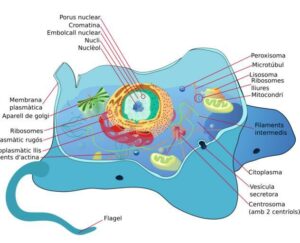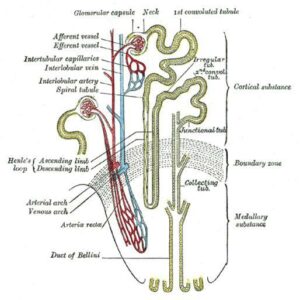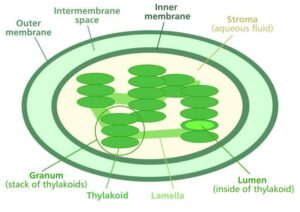Humans are composed of animal cells but only of a single specific type.
Scientifically, animal cells are the structural and functional units or essentially the building bricks of all organisms that belong to Kingdom Animalia.
They can specify and form any required tissue, organ or organism based on the genomic components.
Animal cells are eukaryotic cells(i.e cells containing a defined nucleus), surrounded only by a plasma membrane, unlike plant cells which are enclosed by both cell membrane and cell wall. The absence of the cell wall means the cells do not have a rigid or specific shape. But in contrast, this allows the cells to have different shapes and form different tissues, organs and organ systems.
Human cells are just the specific animal cells that make up humans, for ultimately they are animals as well.
Components of an animal cell:
Generally smaller than plant cells with an irregular shape due to the absence of the cell wall animal cells still come in a variety of sizes based on the organism. But similar to plant cells they have all the other major organelles characteristic of eukaryotes.

Kingdom Animalia begins from Sponges and ends at Mammalia with humans or Homo sapiens sapiens being the most advanced. With the evolution and advancement of the organisms, there is advancement in their cellular complexity, but the main components remain the same.

Credit: Wikimedie
- Cell membrane or the thin covering that protects cells(the thin while layer that we often peel off boiled eggs). The cell membrane allows the cell to exchange gases and also communicate with adjacent cells.
- Nucleus and a nuclear membrane- as animal cells are eukaryotic this means the genetic material is present in a condensed form in a specific organelle i.e. the nucleus instead of floating around in the cell. The nucleus has a nuclear membrane to protect it and also the membrane itself has more important functions in protein synthesis and cell transport.
- Endoplasmic Reticulum or simply the ER is a continuation of the nuclear membrane. They mainly function in synthesizing lipids(fatty substances).
- Mitochondria These organelles are what ultimately break down molecules to release energy. Hence they are called the batteries or powerhouse of the cell.
- Golgi Apparatus and Ribosomes: The ribosomes main function is to synthesize proteins that are received by the Golgi apparatus. They receive them along with lipids from the Endoplasmic Reticulum after which they are transported to their target sites.
- Lysosomes are cell cleaners. They are enzyme filled packets that dispose of or recycle any material that is unwanted in the cell.
- Ribosomes are simply the protein synthesis centres. These are small organelles that are often stuck to the nuclear membrane and the ER.
- Vacuoles are empty pockets that can beused for storing water, waste products or even food by the cell.
Most common types of animal cells:
These include the most common animal cell types that occur most frequently throughout the animal kingdom. These include
- Skin Cells: They occur in all animalsand may have more than one layer called the dermis.
- Muscle cells: Animal are distinguished by their ability to move. Except in the case of unicellular or sedentary (those that do not move)organisms, most animals have muscle cells to help in movement. They also make up
- some important organs like the heart.
- Blood cells or corpuscles are the cellular components present in most animal vascular systems.
- Nerve cells Animal having even the simplest nervous systems have a collection of nerve cells which may just form a ganglion.
- Fat cells Most animals use fat cells present to store food materials for hibernation or morphing.
Some specialized animal cells present in lower animals:
- Choanocyte: Specialised cells in sponges have a flagellum that helps to control the movement and flow of water throughout the cavity of the organism.
- Cnidocytes: Found in cnidarian like jellyfish and hydra these cells are also called stinging cells. They contain organelles called nematocysts – consisting of a coiled thread occasionally with barbs. These cells allow the animal to sting and immobilize prey with poison. (Box jellyfish are one of the most venomous animals in the world)
- Flame Cells: Found specifically in phylum Ctenophora or simply what we call flatworms(most intestinal parasites belong to this category). Since they are not developed flame cells in these animals act as kidneys to filter toxins and waste from the circulating fluid.
How many animal cells does a human have?
Technically speaking humans have only one type of cell i.e the human genomic cell.
Humans are the most complex organism created in nature, consisting of trillions of cells. But they all have the same genomic constituency containing 3 million base pairs. All the cells are grouped according to function and organs. But they are all the same type of animal cell i.e. a human cell.
Though the cell genomic content is the same the all the cells do not have the same structure or function.
The cells have been differentiated in foetal form and they form different tissues, organs and organ systems.
- Neurons: Or nerve cells is the basic unit of the nervous system that controls all bodily functions in the body. These cells carry messages from the brain to all the organs and muscles with the help of small electro-chemical signals.
- Muscle Cells: Comprising of three types(smooth, cardiac and skeletal) these cells form muscles that make movement possible. Cardiac muscles form the heart and its walls, which allows it to rapidly pump blood.It is because these cells are made up of fibres that allow contraction.
- Red Blood Cells: Making up the corpuscular part of blood, these cells have a biconcave discoid shape. The main function of RBCs is to transport oxygen and carbon dioxide to and fro from the lungs. For this purpose, RBCs have an iron component called Haemoglobin that turns red on binding with oxygen giving the red colour; hence the name.
- Leucocytes: Typically called White Blood Cells or WBCs, they make up the immune system in humans. Found in both the blood and the lymphatic system, these cells help us fight against infectious diseases and foreign particles(like allergens).
They are further divided into:
- Neutrophils
- Eosinophils
- Basophils
- Monocyte
- Lymphocytes
Lymphocytes can also be of 3 types– T Cells, B cells and Natural Killer Cells.
- Nephrons: These are specialized cells that are found in Kidneys. They look like a sieve with a large tube and remove the excess salts, waster products and unnecessary materials from the blood.

Image credit: Wikimedia
Do all living things have animal cells?
Animal cells are specific to Kingdom Animalia.
All animals ranging from sponges to mammals are composed of animal cells. These cells can form a simple organism or can form tissues, organs and systems i.e more complex. Some cells may be specifically produced by a certain animal to adapt to its environment.
So animal cells in scientific terms are limited to animals only. Plant cells that make up the major portion of the Earth’s biomass are vastly different in composition. The most important difference is the presence of cell walls and chlorophyll or other pigment-containing organelles. Cell walls made up of polysaccharides are present in all organisms that we consider plants- even unicellular yeast. The cell wall is what gives plant cells their rigidity and the ability to last through a long time(the very reason wood furniture is so long-lasting).
The second biggest difference is the presence of chlorophyll. This is a pigment found in a plant-specific organelle called – CHLOROPLAST. This pigment allows plants to photosynthesize i.e to produce their food in the form of simple sugar(hence the name Autotrophs). Chlorophyll uses light energy as a catalyst and converts atmospheric Carbon Dioxide and water to Glucose and oxygen.

Image credit: Wikimedia
What do animal cells have that humans don’t?
Conditionally as humans are animals, they do not contain an excess or deficit in organelles when compared to a normal animal cell.
Humans are considered as higher beings but being classified in kingdom Animalia means they are animals. Under a microscope, a cell taken from a random animal and one taken from human tissue will not have much difference. This characteristic is what allows scientists to discover how closely one animal species or genus is related to another.
Also Read:
- Do animal cells have a central vacuole
- Do animal cells have flagella
- Do animal cells have a cell wall
- Do animal cells have cilia
- Do animal cells have vacuoles
- Do animal cells have cytoplasm

I am Trisha Dey, a postgraduate in Bioinformatics. I pursued my graduate degree in Biochemistry. I love reading .I also have a passion for learning new languages.
Let’s connect through linked in: